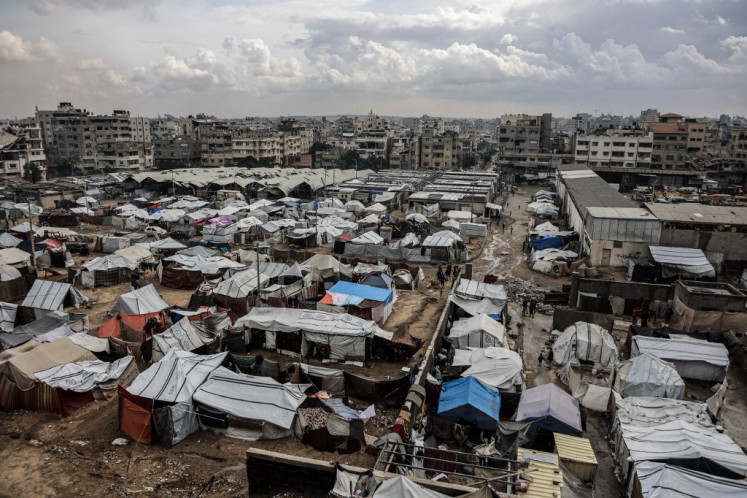Popular Reads
Top Results
Can't find what you're looking for?
View all search resultsPopular Reads
Top Results
Can't find what you're looking for?
View all search resultsHealth starts at home
Healthy air at home: Houses designed with cross ventilation and fitted with an air-conditioner that has a built-in air purifier improves circulation and the air inside a house, and provides an environment that supports healthy living for its occupants
Change text size
Gift Premium Articles
to Anyone
H
ealthy air at home: Houses designed with cross ventilation and fitted with an air-conditioner that has a built-in air purifier improves circulation and the air inside a house, and provides an environment that supports healthy living for its occupants. (JP/Muthi Kautsar)
It is natural that we appreciate our homes more than before, now that most of us are adhering the stay-at-home policy during the COVID-19 outbreak. Every moment from the mundane to the memorable now happens in our homes. We clean our rooms, cook in our kitchen, work in our home office (or living room), and some are even celebrating birthdays or anniversaries in the comfort of their homes.
Our homes are also appearing more often in social media posts in place of the usual photos taken while on holiday or during weekend getaways. And you might suddenly end up feeling the need to renovate or redecorate, or perhaps simply feel grateful that you tended to these last year.
News anchor Mochamad Achir, who recently finished his master degree at University College London, renovated his house in late 2018 and is glad he did, now that he has to spend most of his time at home with his two school-aged children.
“It was the best timing for me [to renovate] as I left for the UK. I made the most out of the available budget, and I had a [contractor] friend who was willing to work within that budget,” said Achir, who returned to Indonesia in late January this year.
He used almost all the money he had on upgrading his house.
“I live in [an old] house that I bought in 2013. It was sold as part of one house divided in two. I had to renovate because of health, safety and aesthetic concerns,” he said.
A healthy house requires proper, natural ventilation and lighting, according to founding architect Willis Kusuma of Willis Kusuma Architects. He explains that the house should be able to “breathe naturally”, use low energy and if possible, generate energy.
Among the latest technologies that can be used to create a healthy home is low-energy air-conditioners (ACs) that come with an integrated filtration system, and which feature in houses built using the smart home concept.
The Savasa cluster housing developed by PT Panahome Deltamas Indonesia in Cikarang, West Java, is one property development that applies the smart home concept. The houses in the cluster feature Puretech air filtration and ventilation systems that claim to protect the interior environment from contaminated air and smog.
Willis said that the smart home concept is automation applied to a house that makes home living more convenient, and apparently can be applied to houses of any design.
He said that there were two smart home categories. The first category covers houses that use clever designs, such as those built with a certain orientation so they do not catch any direct sunlight, which could increase the interior temperature. Another example is a house that has been designed with cross ventilation, which cools the interior of the house naturally, without the use of ACs.
The second category covers houses that use technology – also called home automation – like those that use low emissivity (low-E) glass to restrict the kinds of light that could heat up the interior but without reducing brightness, or solar panels to provide power. This category also includes houses that have been installed with water treatment units or automatic lighting systems to save energy.
Meanwhile, architectural consultant Miranti Gumayana said that a healthy home was one that was fitted with proper filters to reduce indoor pollution, and that the house was built in a location that was free of toxic waste contamination. She said that one project she consulted on needed preconstruction soil treatment, because it was being built on a former swamp.
In addition to cross ventilation and an integrated air-conditioner and -purifier, Miranti also mentioned soundproofing as necessary for a healthy home. The simple placement of vegetation and other landscaping elements could create a “green buffer” to filter out external sounds that might otherwise enter a home.
Other alternatives included “double-glazed windows, as well as acoustic ceiling materials to [soundproof] the house”, she said.
Willis and Miranti both agree that the size of a house doesn’t determine whether it supports the health of its occupants or not.
“A small house could still be a healthy home if it meets good design standards,” said Willis, cautioning that a big house that had poor lighting and air circulation couldn’t be considered healthy.
For homeowners who have had to postpone their renovation plans because of the COVID-19 outbreak, you might instead want to exploit the delay as leeway to take a second look at your plans and see if the house you’ve imagined actually makes for a healthy home.










